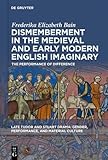Dismemberment in the Medieval and Early Modern English Imaginary : The Performance of Difference / Frederika Elizabeth Bain.
Material type: TextSeries: Late Tudor and Stuart Drama : Gender, Performance, and Material CulturePublisher: Kalamazoo, MI : Medieval Institute Publications, [2020]Copyright date: ©2021Description: 1 online resource (X, 303 p.)Content type:
TextSeries: Late Tudor and Stuart Drama : Gender, Performance, and Material CulturePublisher: Kalamazoo, MI : Medieval Institute Publications, [2020]Copyright date: ©2021Description: 1 online resource (X, 303 p.)Content type: - 9781501517860
- 9781501512957
- 9781501513237
- 822.409354 23/eng/20230216
- online - DeGruyter
- Issued also in print.
| Item type | Current library | Call number | URL | Status | Notes | Barcode | |
|---|---|---|---|---|---|---|---|
 eBook
eBook
|
Biblioteca "Angelicum" Pont. Univ. S.Tommaso d'Aquino Nuvola online | online - DeGruyter (Browse shelf(Opens below)) | Online access | Not for loan (Accesso limitato) | Accesso per gli utenti autorizzati / Access for authorized users | (dgr)9781501513237 |
Frontmatter -- Acknowledgements -- Contents -- Introduction: Attending to Bodies -- Chapter 1: The Symbolic Body and the Performance of Dismemberment -- Chapter 2: Gendered Dismemberments -- Chapter 3: Animals of Dismemberment -- Chapter 4: The Anguish of the Dismemberer: Executioners and Others -- Chapter 5: Coda: After Dismemberment -- Bibliography -- Index
restricted access online access with authorization star
http://purl.org/coar/access_right/c_16ec
The medieval and early modern English imaginary encompasses a broad range of negative and positive dismemberments, from the castration anxieties of Turk plays to the elite practices of distributive burial. This study argues that representations and instances of bodily fragmentation illustrated and performed acts of exclusion and inclusion, detaching not only limbs from bodies but individuals from identity groups. Within this context it examines questions of legitimate and illegitimate violence, showing that such distinctions largely rested upon particular acts’ assumed symbolic meanings. Specific chapters address ways dismemberments manifested gender, human versus animal nature, religious and ethnic identity, and social rank. The book concludes by examining the afterlives of body parts, including relics and specimens exhibited for entertainment and education, contextualized by discussion of the resurrection body and its promise of bodily reintegration. Grounded in dramatic works, the study also incorporates a variety of genres from midwifery manuals to broadside ballads.
Issued also in print.
Mode of access: Internet via World Wide Web.
In English.
Description based on online resource; title from PDF title page (publisher's Web site, viewed 25. Jun 2024)


